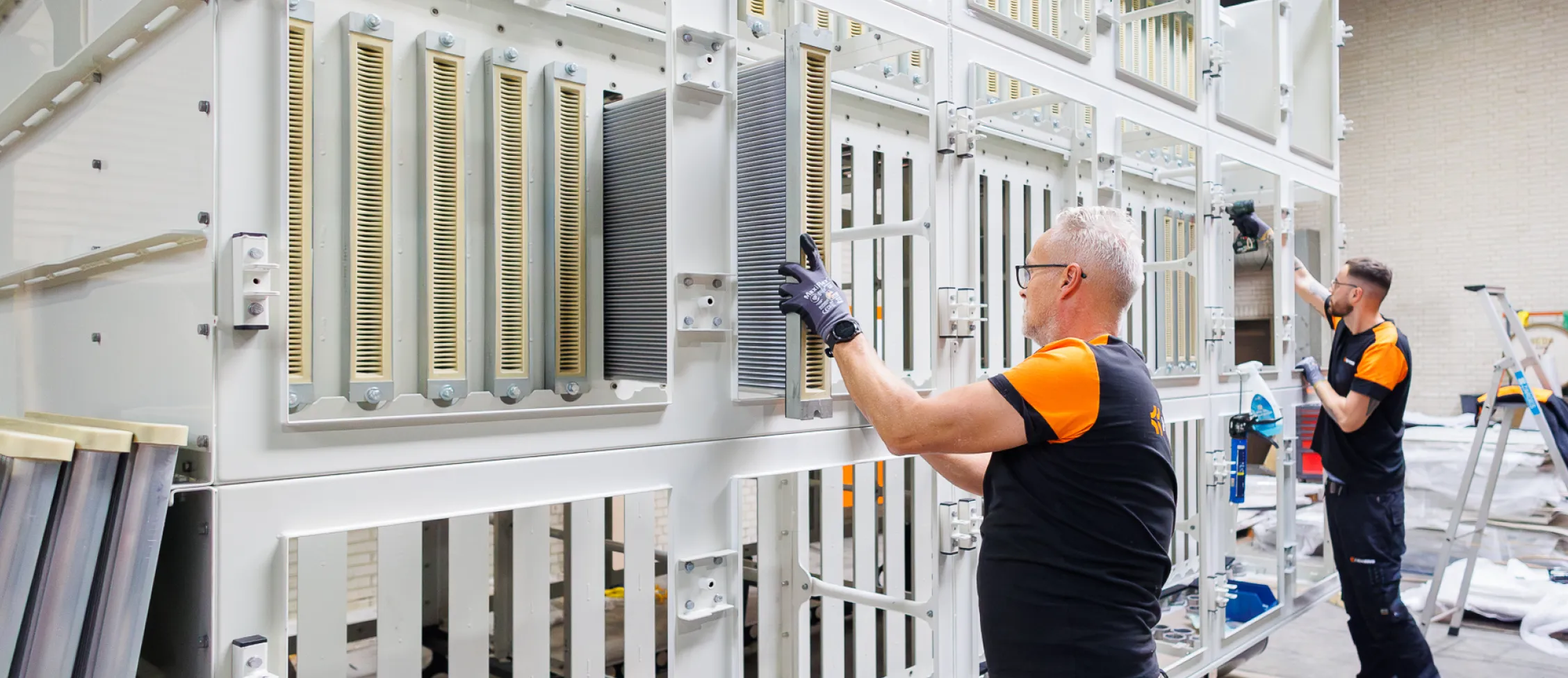Combustible dust

What is flammable dust?
Combustible dust is generated during the processing of various industrial materials and can become explosive when present in sufficient concentration. Due to its extremely large surface area—often many times greater than the original material—it can ignite and burn rapidly, leading to an explosion. Flammable dust particles are released during processes such as grinding, sanding, or milling. Modern techniques like 3D printing also produce fine dust particles. The risk increases significantly when combustible matter mixes with air and reaches critical concentrations. This includes organic substances such as wood, sugar, and grain, as well as metals like aluminum and iron. Even plastics, pharmaceuticals, and textiles can become explosive in dust form.
To prevent explosions, flammable dust particles must be effectively filtered from the air using a high-quality extraction system.
How does a dust explosion occur?
A dust explosion happens when fine, flammable dust particles become suspended in the air and come into contact with an ignition source. Particle size plays a crucial role: only dust particles smaller than 0.5 mm can create an explosive atmosphere. The final ingredients for an explosion? Oxygen in the air and a spark, flame, or hot surface. Common culprits include flour, wood dust, coal dust, and metal dust. When a dust cloud meets an ignition source, an explosion can occur in a fraction of a second.
Types of dust explosions
Dust explosions are classified into different classes based on the strength of the explosion. This is measured with the so-called KST value:
- Dust explosion class St 1: Moderate explosions due to substances such as wood dust or flour (0—200 bar·m/s).
- Dust explosion class St 2: Strong explosions due to, for example, aluminum dust or coal dust (200—300 bar·m/s).
- Dust explosion class St 3: Extremely powerful explosions due to highly hazardous substances such as magnesium dust (over 300 bar·m/s).
Where does flammable dust form? — Risky sectors
Dust explosions are particularly a risk in the following sectors:
- Food industry: For example, due to dust from flour, sugar or cocoa.
- Woodworking: Fine wood dust is extra dangerous in enclosed spaces.
- Metalworking: Aluminium and magnesium dust are highly flammable.
- Chemical industry: The processing of plastics or powders involves a high risk of explosion.
Combustible dust and the ATEX guidelines
The ATEX guidelines regulate how companies must safely manage explosive dust-air mixtures in the workplace. European companies are legally required to protect their employees and installations from these risks. Within the EU, there are two ATEX directives: one for companies that operate installations and are responsible for workplace safety, and one for equipment manufacturers who must ensure their products comply with ATEX requirements. These regulations have been mandatory in Europe since 2006 and serve as a model worldwide, including for the NFPA 652 standard in the US.
Explosion protection in the workplace
Effective explosion protection starts with identifying dust sources and analyzing the flammability of the substance. Companies must prevent dust from accumulating in hard-to-reach areas, such as rooftops or beams. Additionally, smart production methods, machines, and tools help minimize dust formation. Workspaces with a potential explosion risk should be divided into zones and equipped with ATEX-approved equipment. Non-ignition sources and well-grounded machines are essential for safety. And of course, as in any environment, a clean and organized workplace is a safe workplace.
Dust explosion protection
Prevention is the key to safety. Ideally, flammable dust should be avoided altogether by using fewer dust-producing materials or processes. When this is not possible, regular cleaning is essential. Special industrial vacuum cleaners can help by safely removing dust without acting as an ignition source.
In any case, modern extraction and filtration systems are indispensable. They capture dust at the source, preventing the formation of explosive mixtures. Additionally, it is wise to consider spark prevention, the use of explosion-proof equipment, and regular maintenance.
In short: with a well-thought-out safety plan, you can prevent dust explosions and ensure a safe, clean workplace.
Safe dust management with Kiekens
Effective dust management is key to keeping flammable dust under control. At Kiekens, we develop extraction systems that capture dust directly at the source. The collected dust is safely stored in ATEX-approved collection systems, while the purified air is safely returned to the environment.
This prevents dust accumulation in hard-to-reach areas and keeps airborne dust levels under control. The result? Less risk of dust buildup and a significantly safer workplace and production environment.
Kiekens: your partner in explosion protection
Protect your employees and machines from the dangers of flammable dust with Kiekens' modern, ATEX-compliant extraction solutions. Our systems safely and efficiently capture flammable dust, ensure controlled removal, and prevent dust accumulation in the air or on equipment.
And trust us—we know what we're talking about. With decades of experience in designing, delivering, and installing extraction systems, we are true experts in this field.
Curious? Contact us for a customized solution tailored to your workplace, ensuring maximum safety.



